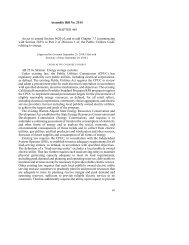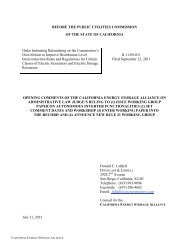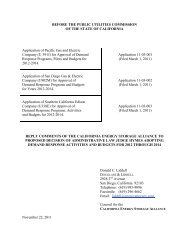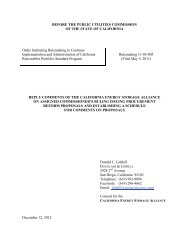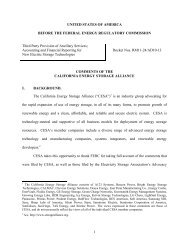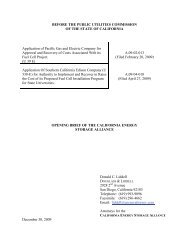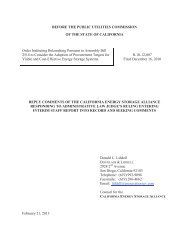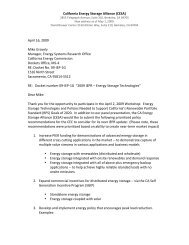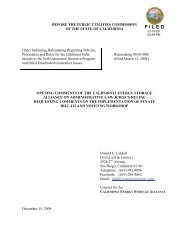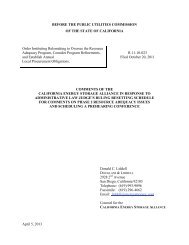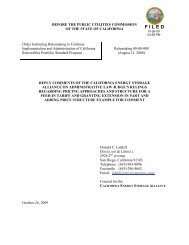SGIP SB 412 Implementation Opening Comments - California ...
SGIP SB 412 Implementation Opening Comments - California ...
SGIP SB 412 Implementation Opening Comments - California ...
You also want an ePaper? Increase the reach of your titles
YUMPU automatically turns print PDFs into web optimized ePapers that Google loves.
BEFORE THE PUBLIC UTILITIES COMMISSION<br />
OF THE STATE OF CALIFORNIA<br />
F I L E D<br />
11-15-10<br />
04:59 PM<br />
Order Instituting Rulemaking Regarding Policies,<br />
Procedures and Rules for the <strong>California</strong> Solar<br />
Initiative, the Self-Generation Incentive Program<br />
and Other Distributed Generation Issues.<br />
Rulemaking 10-05-004<br />
(Filed May 6, 2010)<br />
OPENING COMMENTS OF THE CALIFORNIA ENERGY STORAGE ALLIANCE<br />
ON ADMINISTRATIVE LAW JUDGE’S RULING REQUESTING COMMENTS<br />
ON STAFF PROPOSAL REGARDING MODIFICATIONS TO THE<br />
SELF-GENERATION INCENTIVE PROGRAM<br />
Donald C. Liddell<br />
DOUGLASS & LIDDELL<br />
2928 2 nd Avenue<br />
San Diego, <strong>California</strong> 92103<br />
Telephone: (619) 993-9096<br />
Facsimile: (619) 296-4662<br />
Email: liddell@energyattorney.com<br />
Counsel for the<br />
CALIFORNIA ENERGY STORAGE ALLIANCE<br />
November 15, 2010<br />
1
BEFORE THE PUBLIC UTILITIES COMMISSION<br />
OF THE STATE OF CALIFORNIA<br />
Order Instituting Rulemaking Regarding Policies,<br />
Procedures and Rules for the <strong>California</strong> Solar<br />
Initiative, the Self-Generation Incentive Program<br />
and Other Distributed Generation Issues.<br />
Rulemaking 10-05-004<br />
(Filed May 6, 2010)<br />
OPENING COMMENTS OF THE CALIFORNIA ENERGY STORAGE ALLIANCE<br />
ON ADMINISTRATIVE LAW JUDGE’S RULING REQUESTING COMMENTS<br />
ON STAFF PROPOSAL REGARDING MODIFICATIONS TO THE<br />
SELF-GENERATION INCENTIVE PROGRAM<br />
The <strong>California</strong> Energy Storage Alliance (“CESA”) 1 hereby submits these comments<br />
pursuant to the Administrative Law Judge’s Ruling Requesting <strong>Comments</strong> on the Staff Proposal<br />
Regarding Modifications to the Self-Generation Incentive Program, issued September 30, 2010<br />
(“ALJ’s Ruling”).<br />
I. INTRODUCTION.<br />
CESA begins these comments by expressing deep appreciation for the work of the<br />
Energy Division Staff. The Staff Proposal (“Proposal”) 2 represents a tremendous amount of high<br />
quality work, offers a number of excellent potential solutions to complex problems, and<br />
highlights opportunities to further improve the Commission’s Self Generation Incentive Program<br />
(“<strong>SGIP</strong>”) 3 in the future. Subject to resolution of the points discussed in these comments, CESA<br />
1 The <strong>California</strong> Energy Storage Alliance consists of A123 Systems, Altairnano, Applied Intellectual Capital,<br />
Beacon Power Corporation, Chevron Energy Solutions, Debenham Energy, Deeya Energy, East Penn<br />
Manufacturing Co., Inc., Enersys, Enervault, Fluidic Energy, General Compression, Greensmith Energy<br />
Management Systems, Ice Energy, Lightsail Energy, International Battery, Inc., Primus Power, Powergetic, Prudent<br />
Energy, PVT Solar, Redflow, ReStore Energy Systems, SAFT, Samsung SDI, SEEO, Silent Power, Suntech,<br />
Sunverge, SustainX, and Xtreme Power. The views expressed in these <strong>Comments</strong> are those of CESA, and do not<br />
necessarily reflect the views of all of the individual CESA member companies. http://www.storagealliance.org.<br />
2 Attachment 1 to the ALJ’s Ruling, Self Generation Incentive Program (<strong>SGIP</strong>) Staff Proposal, September 2010.<br />
3 AB 970, codified as Public Utilities (“P.U.") Code § 399.15(b), Paragraphs 4-7; Load Control and Distributed<br />
Generation Initiatives (2000).<br />
1
strongly supports the expeditious implementation of <strong>SB</strong> <strong>412</strong> 4<br />
contained in the Proposal.<br />
and the recommendations<br />
II.<br />
STAND-ALONE ENERGY STORAGE SYSTEMS SHOULD BE ELIGIBLE TO<br />
PARTICIPATE IN THE <strong>SGIP</strong> INDEPENDENT OF ANY OTHER PROCEEDING<br />
OR POLICY DEVELOPMENT.<br />
At Section 4.2.3 Need for Financial Incentives, (pp. 25), the Proposal points out that the<br />
White Paper Proposal Appendix C), to which it refers as authoritative elsewhere, “explicitly<br />
considers customer investment in energy storage as a stand-alone resource and in applications<br />
where it is coupled with distributed solar PV.” CESA strongly disagrees with the conclusion<br />
later in the Proposal that:<br />
“Although the stand-alone storage analysis demonstrates that there may be<br />
some need for financial support for that technology, staff recommends that the<br />
Commission wait until the utilities have completed the cost-effectiveness<br />
evaluation of their permanent load shifting (PLS) pilot programs, undertaken in<br />
their Demand Response portfolios, before determining whether to include standalone<br />
storage in <strong>SGIP</strong>.” (p. 28).<br />
The same “wait and see” approach is suggested again in the Proposal at Section 4.3<br />
Technology Recommendations. (p. 30). Finally, at Section 4.3.6 Energy Storage.<br />
“Stand-alone Energy Storage – Staff notes that many of the same benefits<br />
provided by energy storage coupled with renewable DG can be provided by standalone<br />
energy storage. However, staff notes that that through the Commission’s<br />
Demand Response programs, each of the three large IOUs currently has a pilot<br />
program for permanent load shifting (PLS) resources. These pilot programs<br />
provide incentives for resources that permanently shift load from on-peak to offpeak<br />
times, including energy storage resources. The Commission has ordered the<br />
IOUs to conduct a cost-effectiveness evaluation of the PLS pilot programs, which<br />
is expected in November 2010. Staff recommends that since the PLS pilot<br />
programs and stand-alone energy storage incentives through the <strong>SGIP</strong> might serve<br />
similar purposes, the Commission should be cautious about duplicating efforts.”<br />
(p. 37).<br />
The staffs concern about duplication of effort is inexplicably misplaced. The history of<br />
the <strong>SGIP</strong>, compared with that of Permanent Load Sifting (“PLS”) makes this abundantly clear.<br />
Further, enactment of <strong>SB</strong> <strong>412</strong> clearly provides the Commission the latitude to include any<br />
4 Stats. 2009, ch. 182, effective January 2010.<br />
2
distributed energy resources that achieve reduction of greenhouse gas (“GHG”) 5 emissions –<br />
without conditioning eligibility on events outside the purview of the <strong>SGIP</strong>. Beginning with<br />
enactment of AB 970, the statute that authorized the Commission to create the <strong>SGIP</strong> in 2001, 6<br />
the program was intended to progressively evolve in step with advances in energy technology<br />
and <strong>California</strong>'s energy policy. There is no policy or practical reason to exclude stand-alone<br />
energy storage from the <strong>SGIP</strong>.<br />
In D.99-10-065, issued October 21, 1999, 7 the Commission articulated its very broad<br />
frame of reference for encouraging development of distributed energy resources:<br />
“In this decision we use the term ‘distributed generation’ to refer to those<br />
small scale electric generating technologies such as internal combustion engines,<br />
microturbines, wind turbines, photovoltaics, and fuel cells. We use the term DER<br />
to refer to the distributed generation technologies, storage technologies, end-use<br />
technologies and DSM technologies.<br />
‘Distributed generation’ has also been referred to as ‘distributed energy<br />
resources’ (DER) or ‘distributed resources’ (DR). (OIR, p. 2, fn. 1). DER<br />
appears to be the broadest of all three terms, and includes distributed generation,<br />
as well as energy storage technologies such as battery energy storage,<br />
superconducting magnetic energy storage, flywheel energy storage, and<br />
compressed air energy storage. DER can also refer to targeted “end-use<br />
technologies” or targeted DSM techniques [Emphasis added]” (Mimeo, p. 14).<br />
To date the <strong>SGIP</strong> is the only incentive program that supports energy storage systems.<br />
There are no income or production tax credits, like those that have existed for many years to<br />
encourage renewable resource development. Because its market situation is unique it is critical<br />
that the <strong>SGIP</strong> include all energy storage technologies, and specifically include stand-alone<br />
energy storage. The <strong>SGIP</strong> has also been a very successful commercialization program for many<br />
emerging technologies (e.g. solar, fuel cells, mall wind, etc). Its role for energy storage is even<br />
more strategically important because of the absence of any other energy storage incentives at the<br />
state or federal levels<br />
5 At a minimum, <strong>SB</strong> <strong>412</strong> requires the Commission to administer the <strong>SGIP</strong> so as to assure, in consultation with the<br />
<strong>California</strong> Air Resources Board (“CARB”), that eligible technologies meet or exceed standards adopted by the<br />
CARB pursuant to the Global Warming Solution Act of 2006 (AB 32).<br />
6 AB 970, codified as Public Utilities (“P.U.") Code § 399.15(b), Paragraphs 4-7; Load Control and Distributed<br />
Generation Initiatives (2000).<br />
7 Rulemaking on the Commission's Own Motion to Solicit <strong>Comments</strong> and Proposals on Distributed Generation and<br />
Competition in Electric Distribution Service, R.98-12-015, filed December 17, 1998.<br />
3
As noted above, the Proposal recommends that the Commission consider the results of<br />
the PLS study of ways to encourage PLS that is currently being conducted by Southern<br />
<strong>California</strong> Edison Company, Pacific Gas and Electric Company, and San Diego Gas and Electric<br />
Company (collectively the “Utilities”) ordered by the Commission in D.09-08-027 8 before<br />
deciding how to proceed with incentives for stand-alone energy storage in the self Generation<br />
Incentive Program (“<strong>SGIP</strong>”) 9 . Reasons given for the recommendation are (a) there may be<br />
distinct types of technologies that could be supported through <strong>SGIP</strong> incentives that are not fully<br />
valued in the PLS context, and (b) the Commission may decide that PLS does not belong in the<br />
Demand Response programs.<br />
There are at least two fundamental problems with the Proposal’s recommendation: (a)<br />
there is no necessary logical or policy nexus between the <strong>SGIP</strong> and the PLS study, and (b) the<br />
report that will be produced at the conclusion of the PLS Study is intended to simply inform the<br />
applications for approval of demand response programs and budgets that the Utilities must file<br />
by January 31, 2010, that will be implemented during 2011-1014. The <strong>SGIP</strong> is a mature<br />
program that has been existence since 2001, and is being modified in accordance with policy<br />
mandated by <strong>SB</strong> <strong>412</strong>. PLS, by contrast, is one form of demand response, or energy storage, that<br />
has thus far been funded by the Commission only as a small pilot program, and any expansion of<br />
scope or pace of implementation is entirely unknown at the present.<br />
Presumably because the <strong>SGIP</strong>, although strategically important, is only a subset of much<br />
broader policy initiatives contemplated by the Commission, the Proposal does not mention the<br />
possibility that there will soon be a new energy storage proceeding dedicated exclusively to<br />
energy storage. 10 Recognizing that there will be such a proceeding in the relatively near future,<br />
Ice Energy urges the Commission not to slow down the momentum of this proceeding to allow it<br />
to “catch up” to one that does not yet exist.<br />
8 Decision Adopting Demand Response Activities and Budgets for 2009 through 2011, issued August 20, 2009 in<br />
A.08-06-011, et al.<br />
9 Pursuant to D.09-08-027, Ordering Paragraph 32, the Utilities are conducting a study and have been ordered to<br />
deliver a report of their findings and conclusion by December 1, 2010.<br />
10 See, Electric Energy Storage: An Assessment of Potential Barriers and Opportunities, Commission Policy and<br />
Planning Division White Paper, July 9, 2010, and see AB 2514, enacted September 29, 2010.<br />
4
III.<br />
PEAK LOAD MANAGEMENT SHOULD BE THE FUNDAMENTAL PROGRAM<br />
POLICY GUIDING PRINCIPAL FOR THE <strong>SGIP</strong>.<br />
At the November 1, 2010 workshop it was noted that the Proposal does not refer to the<br />
importance of peak load reduction, and the response was given that it is there implicitly included<br />
though out the entire Proposal. 11 As discussed above, the <strong>SGIP</strong> was originally created for the<br />
sole purpose of encouraging managing of <strong>California</strong>’s peak load usage of electricity. That focus<br />
has, if anything, increased since then, as was highlighted by amendment of P.U. Code §399.15<br />
by AB 1685 in October 2003. AB 1685 added emissions requirements, and also the following<br />
reaffirmation of the original impetus for the <strong>SGIP</strong>:<br />
“(b) In consultation with the State Energy Resources Conservation and<br />
Development Commission, adopt energy conservation demand-side management<br />
and other initiatives in order to reduce demand for electricity and reduce load<br />
during peak demand periods. Those initiatives shall include, but not be limited to.<br />
. . . (6) Incentives for load control and distributed generation to be paid for<br />
enhancing reliability.”<br />
The Legislative Counsel's Digest described the purpose of AB 1685 as follows:<br />
“AB 1685, Leno. Energy: self-generation incentive program: peak<br />
reduction. Existing law requires the Public Utilities Commission on or before<br />
March 7, 2001, and in consultation with the Independent System Operator, to take<br />
certain actions, including, in consultation with the State Energy Resources<br />
Conservation and Development Commission (Energy Commission), adopting<br />
energy conservation demand-side management and other initiatives in order to<br />
reduce demand for electricity and reduce load during peak demand periods,<br />
including, but not limited to, differential incentives for renewable or super clean<br />
distributed generation resources.[Emphasis added]” 12<br />
<strong>SB</strong> <strong>412</strong> is focused on GHG reduction, of course, but it did not reverse, or eliminate the<br />
importance of emphasis on peak load reduction that still remains in P.U. Code §379.6<br />
(renumbered by AB 1536):<br />
“(e) In administering the self-generation incentive program, the<br />
commission may adjust the amount of rebates and evaluate other public policy<br />
11 The fact that the Commission remains steadfast in its historical commitment to maintaining emphasis on peak is<br />
also reflected in the Commission’s memoranda submitted as part of the legislative records of <strong>SB</strong> <strong>412</strong>, and its<br />
companion bill in the 2009 session, AB 1536 (Blakeslee)..<br />
12<br />
See also, Opinion Responding to Petition of the <strong>California</strong> Independent Petroleum Association, D.05-10-025,<br />
issued October 27, 2005; and Opinion Denying the Petition of Tecogen for Modification of D.04-12-045, issued<br />
February 16, 2006.<br />
5
interests, including, but not limited to, ratepayers, and energy efficiency, peak<br />
load reduction, load management, and environmental interests.”<br />
IV. THE MINIMUM ROUND TRIP EFFICIENCY REQUIREMENT FOR<br />
PROGRAM ELIGIBILITY SHOULD BE BASED ON THE MINIMUM RTE<br />
REQUIRED TO BE ‘ON PAR’ WITH A NATURAL GAS FIRED PEAKER. 13<br />
The Staff Report’s analysis of the greenhouse gas (“GHG”) emissions impacts of energy<br />
storage, described in Appendix “A” to the Proposal, indicates that “a minimum round trip<br />
efficiency (“RTE”) of approximately 67.9% is necessary in order to ensure that energy storage<br />
technologies reduce GHG emissions”. CESA strongly supports the need to reduce GHG, as<br />
required by <strong>SB</strong> <strong>412</strong>. CESA also appreciates Staff’s analysis and conclusion that energy storage,<br />
as a technology class, will reduce GHGs by reducing the need for natural gas fired peak<br />
generation resources.<br />
CESA supports establishing a minimum round trip efficiency requirement for<br />
technology-specific storage eligibility in the <strong>SGIP</strong>. Energy storage can and will reduce GHG<br />
emissions as compared to those of a centralized natural gas peaker. However, the specific round<br />
trip efficiency requirement and methodology to arrive at this requirement in order to achieve<br />
GHG reduction goals is debatable. CESA strongly disagrees with the Proposal’s specific<br />
minimum round trip efficiency requirement of 67.9% and its underlying methodology on several<br />
key points, each of which will be discussed in greater detail below, followed by a specific<br />
alternative GHG methodology recommendations:<br />
1. Minimum RTE when coupled with renewable energy – Minimum RTE<br />
requirements should factor in the renewable inputs to charge the system, and<br />
should be treated differently for the purpose of calculating a minimum RTE<br />
standpoint for program eligibility.<br />
2. Staff’s analysis Incorrectly uses the same line loss factor for both charging and<br />
discharging – it is well accepted that line losses on peak will be far greater than<br />
during off-peak times.<br />
13 CESA comments in this Section do not represent a consensus view of all CESA members. Perspectives may<br />
differ on any particular issue in these comments. Minimum required RTE is one area where there are significantly<br />
diverging views. Some CESA members are in favor of postponing a round trip efficiency minimum requirement<br />
until accurate field data on the energy storage systems under the <strong>SGIP</strong> system can be gathered and analyzed.<br />
6
3. Staff should not utilize an annual RTE degradation, as this does not apply<br />
uniformly to all energy storage technologies.<br />
4. Staff’s marginal analysis of a combined cycle gas turbine (“CCGT”) overestimates<br />
emissions of baseload generation – Staff incorrectly uses the marginal<br />
emissions profile of a CCGT to determine the emissions profile of the energy<br />
used to charge the storage system. The emissions profile of the actual ‘energy<br />
mix’ used at baseload/off peak times would be a far more accurate representation<br />
– this mix should include renewables and other carbon neutral sources, and should<br />
factor in potential future renewable over generation in the mix as well as changes<br />
in the overall baseload composition over time.<br />
Minimum RTE When Storage is Coupled with Renewable Energy<br />
Staff assumed that energy storage technologies, regardless of whether they are coupled<br />
with a renewable <strong>SGIP</strong>-eligible technology, would charge primarily from the grid and primarily<br />
during off-peak hours. Although there will be times in most energy storage coupled with<br />
renewable distributed generation projects that the energy storage system is charged off the grid,<br />
the energy storage system will often use a combination of both the renewable energy and grid<br />
provided power, and there will be other times when it is charged only by renewable energy.<br />
It is widely recognized that renewable energy resources do not always produce power<br />
when it is most needed at times of peak demand, and, that existing levels of distributed<br />
renewables are rapidly approaching statewide net metering caps 14 . Additionally, at the project<br />
level, net metering is limited to projects less than 1 MW in size. Thus for all projects that exceed<br />
1 MW, there may be excess generation that might not be net-metered and instead could be used<br />
to charge the on-site energy storage system. For example, this could either be excess wind<br />
energy at night or solar generation before or after the period of peak demand during the day. If<br />
this generation exceeds coincident demand and if net metering is unavailable, then without<br />
energy storage, this “off-peak,” excess generation would go to waste. Instead, energy storage<br />
can be used to store this excess generation for use at other high-value times. This is one of the<br />
14 http://www.cpuc.ca.gov/PUC/energy/DistGen/netmetering.htm<br />
7
main benefits of coupling large capacity energy storage systems with renewable resources, a<br />
benefit that was not taken into consideration in the Proposal.<br />
CESA recommends that minimum RTE requirements for integrated energy storage<br />
coupled with renewable energy projects should factor in the absence of emissions from<br />
renewable inputs to charge the system for the purposes of determining minimum round trip<br />
efficiency to meet GHG requirements established by <strong>SB</strong> <strong>412</strong>. The following discussion relates<br />
only to the roundtrip efficiency minimum requirement for stand alone storage.<br />
Staff’s Analysis Incorrectly uses the Same Line Loss factor for both Charging and Discharging<br />
Line losses of 7.8% were assumed for both charging and discharging. It has been<br />
scientifically proven that as more current passes through power lines and the ambient<br />
temperature increases (which is the case during peak times), line losses will increase as well.<br />
This invariably results in the line losses during peak times being greater than during off peak<br />
times. A Sandia report published in 2010 15 describes these losses as follows:<br />
“As with any process involving conversion or transfer of energy, energy<br />
losses occur during electric energy transmission and distribution. These T&D<br />
energy losses (sometimes referred to as I 2 R or ‘I squared R’ energy losses) tend to<br />
be lower at night and when loading is light and higher during the day and when<br />
loading is heavy. T&D energy losses increase as the amount of current flow in<br />
T&D equipment increases and as the ambient temperature increases. Thus, losses<br />
are greatest on days when T&D equipment is heavily loaded and the temperature<br />
is high.”<br />
Transmission and distribution (“T&D”) line loss factors were presented by E3 at the<br />
November 10, 2010 PLS Workshop and broken down by summer and winter peak, mid-peak,<br />
and off-peak time periods. 16 As an example, the net difference between summer peak and offpeak<br />
line losses in PG&E territory was approximately 5%. Based on these findings, CESA<br />
recommends factoring in different line loss assumptions for peak vs. off peak times to determine<br />
minimum RTE requirements for stand alone storage.<br />
15 Eyer, Jim and Garth Corey. Energy Storage for the Electricity Grid: Benefits and Market Potential<br />
Assessment Guide. Sandia Report SAND2010-0815. Printed February 2010. Page 138<br />
16 Slide No. 44 of the CPUC November 10 th PLS Workshop<br />
(http://www.ethree.com/documents/SCEPLS/PLS%20Workshop%202%20Final.pdf)<br />
8
Staff Should Not Utilize an Annual RTE Degradation Across all Technologies<br />
According to the Proposal, “Round trip efficiency was assumed to degrade by 1% per<br />
year, resulting in a greater charging requirement to achieve the same discharge.”<br />
Energy storage technologies span a wide range of major classes (chemical, thermal, mechanical,<br />
etc.) technology types (within chemical, for example, there are Li-ion, Sodium Sulphur, many<br />
types of flow batteries for example). For some technologies, as they age, capacity may be<br />
affected while round trip efficiency remains unchanged. On its face, it follows that the<br />
degradation percentage assumption made in the Staff Report simply cannot be applied across the<br />
board to all types of energy storage technologies. CESA thus recommends that the minimum<br />
RTE requirement not include an annual degradation factor.<br />
Staff’s Marginal Analysis of Combined Cycle Gas Turbine Over-estimates the Emissions Profile<br />
of Baseload Generation and Should Factor in Over generation<br />
To arrive at the recommended 67.9% roundtrip efficiency minimum, the Proposal<br />
assumed that on-peak emissions would be equal to “a combustion turbine (“CT”) with a heat rate<br />
of 10,807 Btu/kWh, which translates into an emissions factor of approximately .575 Tonne<br />
CO2E/MWh.” Off-peak emissions would be equal to a CCGT “with a heat rate of 6,917<br />
Btu/kWh, which translates into an emissions factor of approximately .368 Tonne CO2/MWh.”<br />
This latter assumption is perhaps the most significant flaw in the staff methodology for a couple<br />
of reasons. First, energy storage systems deployed under the <strong>SGIP</strong> will not be solely charged by<br />
a CCGT – they will be charged from either on-site renewable energy systems or grid energy<br />
during off peak times. Grid energy tends to be much cleaner than pure CCGT output, as it<br />
represents a mix of gas generation, renewables and baseload hydro and nuclear generation.<br />
Secondly, the emissions profile of off-peak generation will, over time, increasingly factor in<br />
more renewable generation, and potentially, the over-generation of wind power.<br />
Renewable over-generation (occurring during off-peak times) is forecasted to be quite<br />
significant by 2020. The following charts were presented by E3 at the November 10, 2010 PLS<br />
Workshop. The yellow area under the curve represents the must-run net load and the black area<br />
represents the anticipated synchronous wind generation expected in 2020 under a 33%<br />
Renewables Portfolio Standard (“RPS”). The underlying analysis assumes wind penetration of<br />
9
8800 MW and a resulting 1700 hours of over-generation, occurring for the most part in the<br />
spring and off-peak hours. If energy storage systems are absorbing the wind over generation<br />
during these times, then there will be no need to curtail the valuable wind generation in the<br />
system.<br />
The above over-generation analysis also implies that <strong>California</strong>’s off-peak energy mix<br />
will be come cleaner over time, as more and more renewable generation is phased in. This also<br />
implies that off-peak charging of energy storage systems will become cleaner over time making<br />
10
the <strong>SGIP</strong> GHG-neutral minimum round trip efficiency requirement a moving target that is<br />
decreasing over time. Thus, any minimum round trip efficiency requirement established today<br />
must be revisited on a regular basis, annually at a minimum.<br />
As described above, <strong>California</strong>’s off-peak generation mix will increasingly become<br />
cleaner as renewable, especially wind penetration increases. Therefore, using CCGT emissions<br />
assumptions will not be accurate for the actual emissions profile of the resource that will be used<br />
to ‘charge’ the energy storage systems during off-peak times<br />
CESA’s Recommended Minimum RTE Calculation Approach: CESA recommends<br />
the following approach to calculate the minimum round trip efficiency required for GHG<br />
neutrality. Specifically, CESA’s approaches use the following assumptions:<br />
1. Keep assumptions for CT (0.575 Tonne CO2E/MWh) and CCGT (0.368 Tonne<br />
CO2/MWh) the same key assumptions as used in the Proposal<br />
2. Use separate assumptions for on-peak line losses and off-peak line losses based<br />
on the information presented above, assuming a 5% differential.<br />
3. Remove the round trip efficiency annual degradation factor using the arguments<br />
listed above<br />
4. Calculate the off-peak charging emissions profile based on the entire generation<br />
mix, not solely the marginal CCGT emissions as used in the Staff Proposal<br />
because of the following:<br />
a. Generation assets in <strong>California</strong> currently have excess capacity, which<br />
include base load, off-peak assets 17<br />
b. Over-generation of renewables (particularly wind), will increase over time<br />
and will have to be curtailed without technologies such as energy storage<br />
to utilize the excess generation 18<br />
c. GHG neutral assets within the generation mix include nuclear, large<br />
hydro, and renewables (the CCGT and CT emissions has already been<br />
adjusted for renewables in the CO2/MWh emissions estimate from the<br />
17 Slide No. 37 of the CPUC November 10 th PLS Workshop<br />
(http://www.ethree.com/documents/SCEPLS/PLS%20Workshop%202%20Final.pdf)<br />
18 Slide No. 54 of the CPUC November 10 th PLS Workshop<br />
(http://www.ethree.com/documents/SCEPLS/PLS%20Workshop%202%20Final.pdf)<br />
11
Staff Proposal and is excluded from CESA’s GHG neutral generation mix<br />
to avoid double counting of GHG benefits)<br />
5. Calculate the on-peak discharging emissions reduction using the same<br />
methodology as the Staff Proposal—storage is a CT substitute<br />
Using the assumptions listed above, and choosing PG&E territory as an example location,<br />
below are CESA’s minimum round trip efficiency requirements for GHG neutrality. PG&Especific<br />
assumptions were taken from PG&E’s available information on 2008 generation mix<br />
data 19 and E3’s November 10, 2010 PLS Workshop that included line loss data for PG&E 20 .<br />
19 PG&E 2008 Generation Mix<br />
(http://www.pge.com/myhome/edusafety/systemworks/electric/energymix/index.shtml)<br />
20 Slide No. 44 of the CPUC November 10 th PLS Workshop<br />
(http://www.ethree.com/documents/SCEPLS/PLS%20Workshop%202%20Final.pdf)<br />
12
The percentage of carbon neutral generation (nuclear and large hydro) in PG&E territory<br />
is 38%, as a percentage of total generation. Assuming the rest of the mix is marginal CCGT<br />
generation, the CCGT emissions should be weighted by 62%, and further adjusted for net<br />
reduction in T&D line losses (assume 5% for PG&E) due to the distributed nature of the <strong>SGIP</strong><br />
projects. Using these assumptions, one can then solve for the minimum roundtrip efficiency<br />
similar to the process used in the Staff Proposal’s GHG Analysis Workbook. This methodology<br />
indicates that the minimum RTE to be ‘on par’ with a natural gas peaker is 38%. 21<br />
In summary, the Proposals’s minimum RTE assumptions are not reasonable and should<br />
be significantly reduced. CESA strongly recommends that round trip efficiency should be based<br />
on minimum efficiency required to be ‘on par’ with a centralized natural gas-fueled CT power<br />
plant, assuming that energy storage is ‘charged’ either with 100% renewables or a reasonable<br />
mix of baseload power which over time, will contain more and more renewables, particularly<br />
when factoring in renewable energy over-generation. Certainly, energy storage coupled with<br />
renewables should be completely exempt from having to meet any minimum round trip<br />
efficiency requirement at all.<br />
Finally, it is worthwhile to mention there are several technology classes which would be<br />
at risk of being excluded if the minimum RTE was set at 70%, including for example, sodium<br />
sulfur, compressed air (“CAES”), and flow batteries (several different types/chemistries). This is<br />
very problematic as these technology classes make up a significant number of emerging energy<br />
storage technologies, and, such technologies may perform as well if not better in the field under<br />
certain field conditions than their higher efficiency-rated (from a specification standpoint)<br />
counterparts.<br />
Energy storage, similar to renewable energy, represents a diverse range of technology<br />
classes ranging from chemical, mechanical, thermal and gravitational, with many different<br />
21 The calculation steps for getting to a 38% minimum round trip efficiency requirements for GHG neutrality are<br />
similar to the process used in the Staff Proposal’s GHG Analysis Workbook:<br />
1. The marginal CCGT emissions is weighted by 62% to account for the GHG neutral generation<br />
mix: 0.368 Tonne CO2/MWh * 62% = 0.228 Tonne CO2/MWh<br />
2. Step #1 result is adjusted for net T&D line loss reductions: 0.228 Tonne CO2/MWh * (100%-5%)<br />
= 0.217 Tonne CO2/MWh<br />
3. The minimum round trip efficiency required to equal CT on-peak emissions given the result in<br />
Step #2 is solved for: 0.217 Tonne CO2/MWh / 0.575 Tonne CO2/MWh = 38% RTE<br />
13
specific technologies within each class. Renewable solar energy, for example, includes many<br />
different technologies and technology subclasses: photovoltaics (“PV” polycrystalline, thin film,<br />
etc.), solar thermal (domestic hot water), concentrating solar thermal (industrial hot water), solar<br />
thermal electric and so on. Each of these solar technologies is used in a different application and<br />
has a different efficiency metric. It would be impossible to create an efficiency metric that<br />
would apply consistently to all of these subclasses of solar technologies. Similarly, it is difficult<br />
to create a meaningful efficiency metric that would apply to all storage technologies, especially<br />
since the actual round trip efficiency will vary tremendously in the field depending on the<br />
application, how the energy storage system is used, and other specific field parameters such as<br />
ambient temperatures etc.<br />
For grid PV <strong>California</strong> is fortunate to have several decades of field performance to guide<br />
our understanding of how such technologies perform in the field relative to the PV module<br />
factory rating. Unfortunately for energy storage, there are today no consistent standards for<br />
setting the factory rating, much less the anticipated field performance.<br />
From a policy standpoint, the minimum RTE should be set high enough so that the GHG<br />
goals set forth in <strong>SB</strong> <strong>412</strong> are achieved, yet not too high so as to exclude technologies that can<br />
positively contribute to GHG reductions in the field. CESA further recommends that installed<br />
systems under the <strong>SGIP</strong> would be required to monitor necessary performance data (see Appendix<br />
1 to these comments for suggested monitoring requirements) to retroactively analyze actual field<br />
performance – this analysis could then be used to amend round trip efficiency requirements at a<br />
future date based on actual field performance and actual off-peak generation mix emissions.<br />
V. A PERFORMANCE BASED INCENTIVE THAT INCENTIVIZES BOTH<br />
DEMAND AND ENERGY WILL RESULT IN GREATER ACCOUNTABILITY<br />
AND OPTIMIZED BENEFITS FOR RATEPAYERS<br />
The Proposal contemplates a new incentive structure, which would distribute incentive<br />
payments over time and link the payments to performance as measured by availability. CESA<br />
recognizes the need for long-term project accountability, and strongly supports the need for<br />
performance-based incentives for all eligible <strong>SGIP</strong> technologies. However, CESA disagrees<br />
with the Proposal in three key ways:<br />
1. Payment conditions - annual project specific performance payments should not be<br />
linked to meeting project-specific round trip efficiency targets.<br />
14
2. Performance-Based Incentive Payment Structure – should not be tied to<br />
availability. A better and more direct way of incentizing performance is to<br />
provide incentives directly tied to <strong>SGIP</strong> program goals; in the case of energy<br />
storage, this would for energy storage’s direct demand and energy benefits.<br />
3. Performance-Based Incentive Levels – should factor in the time value of money if<br />
incentives are to be paid at a future time.<br />
Each of these points will be discussed in more detail below, with suggestions for an<br />
alternate approach that would incentivize performance and ensure that <strong>SGIP</strong> funds are wisely<br />
used on behalf of all ratepayers:<br />
Payment Conditions<br />
CESA recommends against using RTE as a condition for payment for performance based<br />
incentives. From a ratepayers’ perspective, true performance and compensation for performance<br />
should be tied to the program goals/objectives to achieve maximum accountability. For<br />
distributed generation resources, true performance should be tied to total kWh delivered – thus,<br />
for these technologies, one would expect <strong>SGIP</strong> incentives to be paid on a $/kWh delivered basis,<br />
similar to how incentives are currently paid in the <strong>California</strong> Solar Initiative program. For<br />
energy storage in the <strong>SGIP</strong>, the key goal is peak load reduction. Peak load reduction has both a<br />
capacity and an energy benefit to the system as a whole, and should be incentivized as such.<br />
(CESA recommendations for incentive structure are discussed further below, under<br />
“Performance Based Incentive Payments Structure”)<br />
Round trip efficiency is an input to a project pro forma, a driver of project economics –<br />
not the end-goal of the program! Further, actual round trip efficiency will vary tremendously<br />
based on the use case and project specific parameters and cannot be divorced from duty cycle.<br />
Because of the dearth of actual deployed grid customer sited grid energy storage projects today,<br />
it is very hard to characterize in advance anticipated duty cycle on a per project basis. Duty<br />
cycle, and hence, actual RTE, will vary tremendously by customer load shape and specific use of<br />
the storage system. Because these factors are not possible to precisely forecast in advance of<br />
project implementation, it would be difficult if not impossible to forecast round trip efficiency<br />
with an accuracy of +/- 2% for any given project. Further, requiring annual calculations of actual<br />
round trip efficiency at the project level would be onerous if not impossible for <strong>SGIP</strong>-Program<br />
15
Administrators to implement, as this would require very large volumes of data and analysis for<br />
each project; adding unnecessary administrative cost to the program; particularly when a far<br />
superior method of incentivizing true performance is possible.<br />
Performance Based Incentive Payments Structure<br />
A better approach would be to create a hybrid incentive that provides incentives for<br />
meeting demand reduction on a kW basis, as well as an energy-based incentive for delivering<br />
kWh during the six hour peak window throughout the state during summer months. CESA<br />
recommends that the <strong>SGIP</strong> storage incentive be split accordingly. The capacity-based incentive<br />
can be paid up front and the energy incentive can be paid over time based on actual kWh<br />
delivered during qualified peak times over a five year period, consistent with the incentive payout<br />
duration recommended in the Proposal.<br />
Because the capacity incentive is separate from the energy incentive, the minimum<br />
duration requirement for the capacity component can be significantly reduced from the current<br />
level of four hours. CESA recommends maintaining a shortened duration requirement for<br />
eligibility of the capacity based incentive to avoid incentivizing very short duration<br />
uninterruptible power supply, or ‘UPS’ solutions. To ensure that the peak energy is delivered<br />
during peak periods throughout the year, CESA recommends basing the maximum kWh energy<br />
incentive on the total peak hours during any given year as follows:<br />
129 days per year (total number of weekdays during 6 months average peak<br />
period) x 6 hours per day (noon to 6 pm – peak period used in all utility TOU<br />
tariffs) x 90% availability of the energy storage system, or a maximum of 697<br />
hours per year.<br />
By splitting the capacity and energy incentive for storage, the CPUC will be encouraging<br />
the widest possible set of energy storage technologies and applications. For example, energy<br />
storage technologies that are primarily demand or capacity focused can still participate and<br />
provide valuable demand reduction benefits, even if they are not discharged for hundreds of<br />
hours each year. Similarly, storage technologies that can provide significant peak load shifting<br />
in terms of kWh will be rewarded for their ability to move energy from peak to off-peak periods,<br />
commensurate with their actual ability to do so.<br />
16
Performance Based Incentive Levels<br />
The specific incentive levels for the capacity and energy incentive components can be<br />
easily calculated based on existing incentive levels and CESA-proposed renewable incentives for<br />
energy storage. 22 For example, the capacity-based portion of the incentive could be paid upon<br />
project commissioning based on a percentage of the current incentive (either $2/Watt for<br />
standalone, or $2.50/Watt coupled with renewables), similar to how storage <strong>SGIP</strong> incentives are<br />
paid today. The remaining incentive would then be applied toward the energy-based incentive<br />
and would be paid over time according to the number of actual kWh delivered on peak, up to a<br />
maximum of six hours per qualifying peak day (excludes weekends and holidays during peak<br />
summer months). The resulting $/kWh incentive would need to factor in a reasonable estimate<br />
for the risk-adjusted time value of money to achieve comparable project economics to what is<br />
available today. By linking the energy-based incentive purely to actual kWh delivered on peak,<br />
the applicant is not only taking on financing costs and inflation but also 100% of the<br />
performance risk associated with the energy value of the energy storage. CESA supports the<br />
staff recommendation of 15% internal rate of return to be used as the risk-adjusted time value of<br />
money for the purposes of this calculation.<br />
By structuring the new <strong>SGIP</strong> energy storage incentive in this way, the incentive amounts<br />
would be aligned with current and requested incentive levels 23 , while providing the<br />
accountability benefits of a long-term payment plan, a payment plan that would be in effect if<br />
and only if the asset delivered kWh on peak. CESA would like to add that its comments in this<br />
regard pertain ONLY to energy storage, as current incentives may not be appropriately set for<br />
other technologies in the <strong>SGIP</strong>, in particular renewable fuel incentives.<br />
Under this hybrid performance-based incentive approach, <strong>SGIP</strong> participants would<br />
receive incentives for clipping their respective peak demand on a capacity basis, as well as<br />
receive incentives to shift peak energy consumption to off-peak periods…commensurate with the<br />
actual volume of peak consumption shifted. By paying only for performance in this regard,<br />
program accountability will be increased. Finally, measuring actual kWh’s on peak is easily<br />
22 CESA recommended $2.50/W incentive for energy storage applications coupled with renewables (wind, solar or<br />
renewable DG) in its 12/09 filing<br />
23 in its 12/09 filing, CESA requested $2.00/W for standalone storage, and $2.50/W for storage coupled with<br />
renewable energy systems<br />
17
monitored and tracked, thus this incentive mechanism should reduce overall administrative costs.<br />
Further, a performance-based incentive mechanism based on actual kWh delivered could easily<br />
be extended to other eligible <strong>SGIP</strong> technologies such as fuel cells, microturbines or distributed<br />
wind, further simplifying and standardizing program administration across technologies.<br />
VI.<br />
THE <strong>SGIP</strong> FUNDING FRAMEWORK SHOULD PRESERVE RELATIVE<br />
FUNDING LEVELS FOR ALL <strong>SGIP</strong>-ELIGIBLE TECHNOLOGY<br />
CATEGORIES.<br />
The Proposal recommends, “The designations “Level 2” and “Level 3” should be<br />
eliminated. CESA agrees with the recommendation in the Proposal because they were only<br />
useful when the <strong>SGIP</strong> employed three separate budget categories. Today, with no “Level 1” the<br />
original designations are out of date and confusing for customers. Instead, CESA recommends<br />
that the <strong>SGIP</strong> budget should be divided equally between “renewable” and “non-renewable”<br />
categories.”<br />
The Commission created the <strong>SGIP</strong> as a peak load reduction program to implement the<br />
intent of AB 970. To be consistent with this state goal (and with the discussion in the Proposal)<br />
CESA recommends that the current funding framework be modified so that, in addition to<br />
renewable and non renewable allocations, there are also program budget allocations for peak<br />
load reducing and base load distributed energy resources, essentially creating four funding<br />
categories as follows:<br />
18
Under this proposed framework, new eligible technologies applying for <strong>SGIP</strong> incentives<br />
would apply for one of these four funding categories. Energy storage would only be able apply<br />
for peak load reducing funding and should be eligible for Category 3 and Category 4 incentives<br />
as follows:<br />
Category 3: Energy storage coupled with any form of renewable distributed energy<br />
resource (e. g. wind, solar, ocean, fuel cells operating on renewable fuel).<br />
Category 4: Energy storage operating ‘standalone’ or in conjunction with any form of<br />
renewable energy resource, as well as energy storage technologies coupled with any form of<br />
distributed energy resource using non-renewable fuels (e. g. fuel cells operating on natural gas).<br />
In both of the above categories, energy storage should be permitted to charge from the<br />
grid at night, and to be discharged during peak times. This would serve to improve <strong>California</strong>’s<br />
load factor substantially and help reduce the amount of peak demand. Energy storage should<br />
also be permitted to charge directly from the renewable resource itself (wind/solar) or use<br />
regenerative power (e.g. otherwise wasted mechanical or heat energy that can be converted for<br />
use later). Energy storage should also be allowed apply for funds from the non-renewable<br />
category when coupled with wind, solar and any other <strong>SGIP</strong>-eligible generating technologies.<br />
As noted in the Introduction to the Background Section of the Proposal (p. 10) energy<br />
storage technologies offer multiple benefits. CESA therefore proposes that energy storage<br />
systems that receive <strong>SGIP</strong> funding also be allowed to provide emergency backup power to end<br />
19
use customers, and/or provide ancillary services to load serving entities and/or the <strong>California</strong><br />
Independent System Operator. These additional services for <strong>SGIP</strong>-funded energy storage<br />
systems should only be allowed if they are technically able to provide them reliably, and still<br />
meet onsite customers’ peak demand reduction performance requirements.<br />
VII.<br />
METERING REQUIREMENTS SHOULD BE TECHNOLOGY-SPECIFIC.<br />
To create a successful grid energy storage program and market in <strong>California</strong>, the ability<br />
to measure and monitor actual field performance is critical. In general a metering requirement<br />
similar to the CSI’s “Section 5” Solar Metering requirements is envisioned with additional data<br />
appropriate to energy storage. The following comments assume the same requirements, details<br />
and resources as listed in Section 5 of the current CSI Handbook unless otherwise detailed<br />
below.<br />
1. Existing approved Performance Monitoring and Reporting Services (“PMRS”) should<br />
be allowed to expand their services to report on storage as well as solar so long as the<br />
data requirements are clearly identified. Upgrades to current PMRS services should<br />
be encouraged.<br />
2. As most energy storage systems will require a unique or dedicated service for data<br />
reporting and collection the Commissions should enable a special communication<br />
tariff specifically for the purpose of energy performance data collection and control<br />
that cellular providers would have to offer. All cellular providers today offer<br />
significant capability in data only but can charge upwards of $1000/year for the<br />
necessary bandwidth to monitor an installed energy storage system. CESA<br />
recommends a 2 gigabyte per month data plan for no more than $10 per month plus<br />
cost of equipment specific to Energy Performance Monitoring.<br />
3. Data specific to energy storage should include:<br />
a) Location identifier<br />
b) Meter(s) being monitored. If multiple meters, a unique identifier for each<br />
meter should be included<br />
c) Interval of data (1 min, 3 min, 5 min or 15 minute) by Meter and Device (15<br />
minutes for residential systems)<br />
d) Renewable Generator(s) present with identifier and type of generator (Fuel<br />
Cell, Solar PV, Thermal, CHP, gas, hydro, other) by Meter<br />
e) Storage unit(s) identifier with association to each meter<br />
f) For each interval for each meter for each device for each phase of power:<br />
(i) Time stamp of reading based on GMT<br />
(ii) kWh in interval<br />
20
(iii) Average kW in interval<br />
(iv) Power factor in interval (except for residential)<br />
(v) Direction of net flow in interval (To Grid (+) or from Grid (-) )<br />
g) For each interval for each storage system present indicate the current state of<br />
capability in kWh and kW<br />
4. This data should be able to be stored for not less than 2 reporting intervals in the local<br />
metering unit (For example: 6 months if reported quarterly).<br />
5. Meter display via web (internet) or local display device should be acceptable.<br />
6. Accuracy should be required to be at least +/- 2%.<br />
7. The metering should allow the system owner to see real time performance for the<br />
readings (based on interval length) and notify the owner if the system is not<br />
functioning.<br />
VIII. A FIVE-YEAR WARRANTY REQUIREMENT FOR ENERGY STORAGE<br />
SYSTEMS IS REASONABLE.<br />
The Staff Proposal states that, “a five-year warranty on an asset that is expected to last 10<br />
or 20 years is insufficient.” However, every technology that has started out with the <strong>SGIP</strong><br />
program since 2001 has been allowed to start with a five-year warranty. Energy storage, as a<br />
relatively new technology class, should receive consideration no different from all preceding<br />
technologies. The Commission addressed this point in D.11-08-044:<br />
“We adopt the technical parameters proposed by VRB, but lower the<br />
proposed 20-year minimum warranty requirement. We find it unreasonable to<br />
require a 20-year warranty term for AES, while under the <strong>SGIP</strong>, wind and fuel<br />
cell technologies are required to have only a five-year warranty. Furthermore, the<br />
PAs recommend that we “select a minimum warranty term that encourages the<br />
greatest success in roll-out of the AES technology.” A 20-year warranty term<br />
seems unnecessarily excessive. Therefore, we require a five-year warranty for<br />
AES systems, consistent with the warranty requirements for wind and fuel cell<br />
technologies. We believe that the adopted definition is generic enough to allow<br />
all qualified AES systems to participate in <strong>SGIP</strong>.” (p. 11).<br />
The Commission’s reasoning for maintaining a five-year warranty requirement is just as<br />
correct today as it was the last time it was addressed. CESA recommends maintaining the fiveyear<br />
warranty level for energy storage systems.<br />
21
IX.<br />
THE COMMISSION SHOULD CONSIDER ADOPTING APPLICATION FEES<br />
IN ORDER TO ENCOURAGE ONLY HIGH-QUALITY APPLICATIONS.<br />
The Proposal states that application fees “support program administration, screen out<br />
applicants who did not fully intend to complete projects, and create a disincentive for perpetual<br />
re-application.” CESA agrees with this assessment and strongly supports adopting an<br />
application fee structure, provided it is scaled for project size. For example, a small residential<br />
or small commercial project should pay proportionately less in application fees than a multimegawatt<br />
commercial or industrial project. CESA recommends that the maximum residential<br />
fee not exceed $100. Anything beyond this level would be cost prohibitive for residential<br />
applications. Application fees for larger projects could be scaled proportionately according to<br />
project size, but should be kept to less than 2% of the total incentive award being applied for and<br />
be fully refunded at time of claim filing<br />
X. CONCLUSION.<br />
CESA appreciates this opportunity to comment on the Ruling, and looks forward to<br />
working with the Commission and the parties as this proceeding progresses.<br />
Respectfully submitted,<br />
Date: November 15, 2010<br />
Donald C. Liddell<br />
DOUGLASS & LIDDELL<br />
Counsel for the<br />
CALIFORNIA ENERGY STORAGE ALLIANCE<br />
22
CERTIFICATE OF SERVICE<br />
I hereby certify that I have this day served a copy of <strong>Opening</strong> <strong>Comments</strong> of the<br />
<strong>California</strong> Energy Storage Alliance on Administrative Law Judge’s Ruling Requesting<br />
<strong>Comments</strong> on Staff Proposal Regarding Modifications to the Self-Generation Incentive<br />
Program on all parties of record in proceeding R.10-05-004 by serving an electronic copy on<br />
their email addresses of record and by mailing a properly addressed copy by first-class mail with<br />
postage prepaid to each party for whom an email address is not available.<br />
Executed on November 15, 2010, at Woodland Hills, <strong>California</strong>.<br />
Michelle Dangott
SERVICE LIST – R.10-05-004<br />
abb@eslawfirm.com CManson@SempraUtilities.com fsmith@sfwater.org<br />
ablauvelt@eahhousing.org cmkehrein@ems-ca.com fwmonier@tid.org<br />
abrowning@votesolar.org cmurley@ccleagu.org G1GK@pge.com<br />
adam.simpson@etagen.com colin@tiogaenergy.com gary.barsley@sce.com<br />
adougherty@opiniondynamics.com cp@kacosolar.com geofs@codding.com<br />
aes@cpuc.ca.gov croaman@ccsf.edu george.simons@itron.com<br />
aholtz@fafco.com ctai@edgetechsolar.com ghilberg@tas.com<br />
akbar.jazayeri@sce.com ctoca@utility-savings.com gilligan06@gmail.com<br />
alipanovich@akeena.com DAKinports@semprautilities.com gjs8@att.net<br />
allenseligson@yahoo.com dalbers@americandairyparks.com gjs8@att.net<br />
amber@iepa.com dan@energysmarthomes.net glw@eslawfirm.com<br />
andre.devilbiss@recurrentenergy.com Dana.Rotariu@navigantconsulting.com gmorris@emf.net<br />
andrew.mcallister@energycenter.org dave@skellyelectric.com gopal@recolteenergy.com<br />
andrew@chromasun.com david.eaglefan@gmail.com grant.kolling@cityofpaloalto.org<br />
ann.peterson@itron.com dbp@cpuc.ca.gov gteigen@rcmdigesters.com<br />
annette.gilliam@sce.com dbruder@onsitenergy.com gtrobinson@lbl.gov<br />
arr@cpuc.ca.gov dcarroll@downeybrand.com haines@westnet.com<br />
as2@cpuc.ca.gov dchong@energy.state.ca.us hank@wasteheatsol.com<br />
asteele@hanmor.com deden@energy.state.ca.us heidi.ochsner@cadmusgroup.com<br />
atrowbridge@daycartermurphy.com dennis@ddecuir.com heidi@sunlightandpower.com<br />
AXY4@pge.com df1@cpuc.ca.gov hesusman@stoel.com<br />
bawilkins@sbcglobal.net dgrandy@caonsitegen.com HHH4@pge.com<br />
bbarkett@summitblue.com dil@cpuc.ca.gov hodgesjl@surewest.net<br />
bchao@simmonsco-intl.com dmcfeely@solartech.org HYao@SempraUtilities.com<br />
bchastain@aalrr.com dnemtzow@ice-energy.com info@calseia.org<br />
bcragg@goodinmacbride.com dot@cpuc.ca.gov irene.stillings@energycenter.org<br />
bdille@jmpsecurities.com drauschhuber@comfortenergy.com jackm@calpwr.com<br />
ben.ford@member.ams.org dsanchez@daycartermurphy.com jade.juhl@sfgov.org<br />
ben@solarcity.com dseperas@calpine.com jamckinsey@stoel.com<br />
benjamin.airth@energycenter.org dvidaver@energy.state.ca.us janet.gagnon@solarworldusa.com<br />
bernardo@braunlegal.com e.paul@altaterra.net jarmstrong@goodinmacbride.com<br />
bill@brobecksolarenergy.com ebrodeur@steadfastcompanies.com jason.jones@tiltsolar.com<br />
bjeider@ci.burbank.ca.us ecarlson@solarcity.com jbarnet@smud.org<br />
bkarney@comcast.net efm2@pge.com jconway@paretoenergy.com<br />
blaising@braunlegal.com EGrizard@deweysquare.com Jcox@fce.com<br />
bob.ramirez@itron.com EGuise@NationalEnergySolutionsLLC.com jeanne.sole@sfgov.org<br />
brbarkovich@earthlink.net ek@a-klaw.com Jennifer.Barnes@Navigantconsulting.com<br />
brenda.latter@itron.com eklinkner@cityofpasadena.net jennifer.porter@energycenter.org<br />
c.cruzon@mainstreamenergy.com elee@davisenergy.com JerryL@abag.ca.gov<br />
C2M1@pge.com elee@sandiego.gov jf2@cpuc.ca.gov<br />
CAMb@pge.com elvine@lbl.gov jharris@volkerlaw.com<br />
case.admin@sce.com emackie@gridalternatives.org jhoffman@goodwinprocter.com<br />
cbeebe@sustainable-edge.com emahlon@ecoact.org jholmes@emi1.com<br />
cchappell@sunwatersolar.com ensmith@mwe.com jian.zhang@gridx.com<br />
cem@newsdata.com eric@harpiris.com jim.howell@recurrentenergy.com<br />
CentralFiles@SempraUtilities.com erickpetersen@pvpowered.com jimross@r-c-s-inc.com<br />
chuck.hornbrook@itron.com Eriks@ecoplexus.com jjg@eslawfirm.com<br />
chuck@csolt.net filings@a-klaw.com jk.stevens@cox.net<br />
cjm@cpuc.ca.gov fmazanec@biofuelsenergyllc.com jkarp@winston.com<br />
CJSv@pge.com fnasim@energy.state.ca.us jkhuebner@hotmail.com<br />
clamasbabbini@comverge.com fortlieb@sandiego.gov jlarkin@us.kema.com<br />
cln@cpuc.ca.gov francis@focalpointenergy.com jlin@strategen.com
jmaskrey@sopogy.com fred.lyn@cityofrc.us JLTg@pge.com<br />
jmcfarland@treasurer.ca.gov laurene_park@sbcglobal.net nellie.tong@us.kema.com<br />
JMCLA@comcast.net lgk2@pge.com nes@a-klaw.com<br />
jmgarber@iid.com lglover@solidsolar.com nick.chaset@tesserasolar.com<br />
jna@speakeasy.org liddell@energyattorney.com Nick@goodwin-self.com<br />
jnr@cpuc.ca.gov linda.forsberg@mountainview.gov njfolly@tid.org<br />
joc@cpuc.ca.gov lisab@cleantechsandiego.org NJSa@pge.com<br />
jody_london_consulting@earthlink.net lkelly@energy.state.ca.us nlong@nrdc.org<br />
joelene.monestier@spgsolar.com lmerry@vervesolar.com nmr@cpuc.ca.gov<br />
John.Pimentel@FoundationWindPower.com lmh@eslawfirm.com npedersen@hanmor.com<br />
john@proctoreng.com lnelson@westernrenewables.com nsantos@solarpowerpartners.com<br />
Johng@ecoplexus.com loe@cpuc.ca.gov Paige.Brokaw@asm.ca.gov<br />
johnspilman@netzero.net lp1@cpuc.ca.gov Paul.Tramonte@jpmorgan.com<br />
jon.fortune@energycenter.org lrosen@eesolar.com paul@tiogaenergy.com<br />
jordan@tiogaenergy.com luke.dunnington@recurrentenergy.com pbarthol@energy.state.ca.us<br />
Joseph.Perry@flexenergy.com lwhouse@innercite.com pepper@sunfundcorp.com<br />
jpalmer@solarcity.com m.stout@meridianenergyusa.com peter.thompson@solar.abengoa.com<br />
jpittsjr@pcgconsultants.com marc@negawattconsult.com peter@peterlelievre.com<br />
jrathke@capstoneturbine.com marcel@turn.org phammond@simmonsco-intl.com<br />
jrichman@bloomenergy.com martinhomec@gmail.com pnarvand@energy.state.ca.us<br />
jrohrbach@rrienergy.com mary.tucker@sanjoseca.gov preston@sonomaenergymgt.com<br />
jstanton@solarcity.com matt@criterionmgt.com psaxton@energy.state.ca.us<br />
jtengco@akeena.com matt@sustainablespaces.com pstoner@lgc.org<br />
julia@jasenergies.com matthew.kilkenny@skywatchenergy.com r.raushenbush@comcast.net<br />
julie.blunden@sunpowercorp.com mbriney@cecmail.org rafi.hassan@sig.com<br />
june@globalexchange.org mburnett@edenhousing.org rbaybayan@energy.state.ca.us<br />
justin@sunwatersolar.com mc3@cpuc.ca.gov regrelcpuccases@pge.com<br />
jwiedman@keyesandfox.com mcampbell@opiniondynamics.com rguild@solarcity.com<br />
jwwd@pge.com mdavis@barnumcelillo.com rhuang@smud.org<br />
JYamagata@SempraUtilities.com mday@goodinmacbride.com rhwiser@lbl.gov<br />
kar@cpuc.ca.gov mdd@cpuc.ca.gov rick.ruiz@zenviro.net<br />
karen@klindh.com mdjoseph@adamsbroadwell.com rishii@aesc-inc.com<br />
karin.corfee@kema.com mdorn@mwe.com rjl9@pge.com<br />
katie@sunlightandpower.com meb@cpuc.ca.gov RKC0@pge.com<br />
katrina.fritzintwala@utcpower.com MEWR@pge.com rknight@bki.com<br />
katrina.perez@energycenter.org mgh9@pge.com rl4@cpuc.ca.gov<br />
katrina.phruksukarn@energycenter.org Michael.Brown@utcpower.com rmccann@umich.edu<br />
kbest@realenergy.com michael.hindus@pillsburylaw.com robert.pettinato@ladwp.com<br />
kcooney@summitblue.com michael.mcdonald@ieee.org robert.tierney@utcpower.com<br />
kdavidson@de-solutions.com michael.tomlin@sce.com ronnie@energyrecommerce.com<br />
kdzienkowski@pvtsolar.com michael@awish.net rpistoc@smud.org<br />
kellie.smith@sen.ca.gov michael@ecoact.org rrkriete@earthlink.net<br />
kelly_desy@solfocus.com michaelkyes@sbcglobal.net rsantos@guardian.com<br />
kenneth.swain@navigantconsulting.com mike.montoya@sce.com rsiada@guardian.com<br />
kevin.armstrong@sanjoseca.gov mike@ethree.com rsperberg@onsitenergy.com<br />
kfox@keyesandfox.com mkober@pyramidsolar.com ryan.amador@energycenter.org<br />
kirby.bosley@jpmorgan.com mmattes@nossaman.com rzhang@cityofpasadena.net<br />
kirk@NoElectricBill.com mowrysswr@cox.net sa@zeropex.com<br />
kmerrill@energy-solution.com mpa@a-klaw.com sara@solaralliance.org<br />
kmills@cfbf.com mrw@mrwassoc.com sas@a-klaw.com<br />
Kurt.Scheuermann@itron.com mts@cpuc.ca.gov sbarata@opiniondynamics.com<br />
kxn8@pge.com mvc@cpuc.ca.gov sbeserra@sbcglobal.net<br />
l1sb@pge.com mxw8@pge.com scott@debenhamenergy.com<br />
lau@cpuc.ca.gov myuffee@mwe.com sdhilton@stoel.com
lauren@sunlightandpower.com naronson@fafco.com SDPatrick@SempraUtilities.com<br />
SDPatrick@SempraUtilities.com stanimoto@sna.sanyo.com timea.Zentai@navigantconsulting.com<br />
sebesq@comcast.net steve.peck@peachtreepower.com tjl@a-klaw.com<br />
sendo@ci.pasadena.ca.us steven.huhman@morganstanley.com tom@alcowater.com<br />
sephra.ninow@energycenter.org steven@moss.net tomb@crossborderenergy.com<br />
sewayland@comcast.net susan.munves@smgov.net ttutt@smud.org<br />
sfrantz@smud.org susanne@emersonenvironmental.com unc@cpuc.ca.gov<br />
SGraham@navigantconsulting.com sww9@pge.com vargalaw@MBAY.net<br />
sgreschner@gridalternatives.org t.lipman@berkeley.edu vargalaw@MBAY.NET<br />
shears@ceert.org tam.hunt@gmail.com vidhyaprabhakaran@dwt.com<br />
Shiela.Linao@sce.com taram@greenlining.org walter.gordon@sce.com<br />
Shoeless838@comcast.net tbardacke@globalgreen.org warehouse@mohrpower.com<br />
siobhan.foley@energycenter.org tblair@sandiego.gov wem@igc.org<br />
smiller@energy.state.ca.us tcr@cpuc.ca.gov whughes@smud.org<br />
smita.gupta@itron.com tdfeder@lbl.gov will@solarroofs.com<br />
socal.forum@yahoo.com terry.clapham@energycenter.org william.martini@tecogen.com<br />
spauker@wsgr.com terry.mohn@balanceenergysolutions.com wlscott@earthlink.net<br />
sreineccius@gmail.com thamilton@icfi.com wmb@cpuc.ca.gov<br />
ssachs@aalrr.com Tim@onlinecleanenergy.com WPark@FIRSTSOLAR.COM<br />
ssciortino@anaheim.net tim_merrigan@nrel.gov zfranklin@gridalternatives.org<br />
ssmyers@att.net



